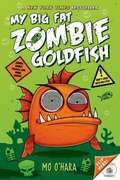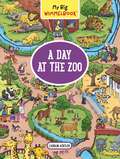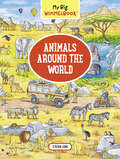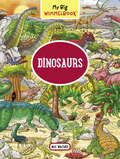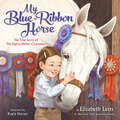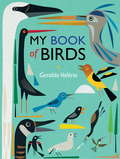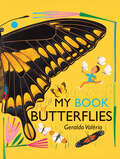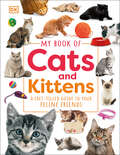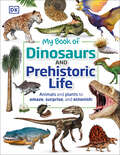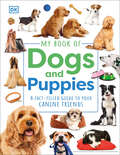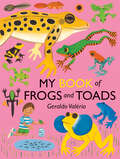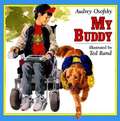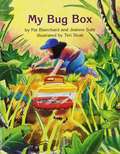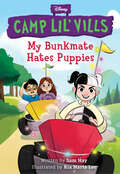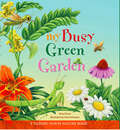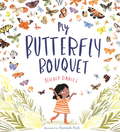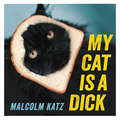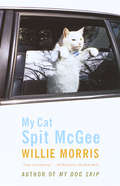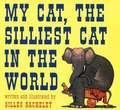- Table View
- List View
My Big Fat Zombie Goldfish
by Mo O'HaraA New York Times bestseller! When Tom's big brother decides to become an Evil Scientist, his first experiment involves dunking Frankie the goldfish into toxic green gunk. Tom knows that there is only one thing to do: Zap the fish with a battery and bring him back to life! But there's something weird about the new Frankie. He's now a BIG FAT ZOMBIE GOLDFISH with hypnotic powers... and he's out for revenge!
My Big Wimmelbook® - A Day at the Zoo: A Look-and-Find Book (Kids Tell the Story) (My Big Wimmelbooks #0)
by Carolin Görtler“Abounding with humor and detail, this brain-building excursion to an illustrated zoo would be a great rainy-day substitute for a real one.”—The Wall Street Journal In these one-of-a-kind picture books, every page is bursting with life—and tons to discover! Children as young as two have a blast pointing out recognizable things—a blue tricycle, a hungry dog, a piggyback ride—while older kids can follow the star characters from page to page, telling their stories along the way. How? Wimmelbooks are virtually instruction-free, inviting kids to make their own way through the busy Wimmelworld they encounter, and to craft their own stories. First, you’re introduced to a unique cast of characters who are hidden in plain sight on the pages that follow. As you seek them out, each character’s storyline unfolds, but it’s up to kids to interpret the scenes and create stories they think fit. It’s hours upon hours of fun—and an effortless introduction to literacy to boot. So welcome to Wimmelzoo! From the wildcat enclosure to the aviary to the monkey house, get ready to explore an array of animal exhibits and spot the characters there to enjoy them in My Big Wimmelbook—A Day at the Zoo. About Wimmelbooks Wimmelbooks originated in Germany decades ago and have become a worldwide sensation with children (and adults!) everywhere. My Big Wimmelbooks is the first-ever Wimmelbook series to feature Wimmelbooks as Wimmelbooks in English. They’ve been praised as “lively . . . and abounding with humor and detail” (WSJ), likely to “make any parent’s heart sing.” (NYT)
My Big Wimmelbook® - Animals Around the World: A Look-and-find Book (kids Tell The Story) (My Big Wimmelbooks #0)
by Stefan LohrMy Big Wimmelbooks let kids ages 2 to 5 be the storytellers with hours of seek-and-find hands-on learning—and fun! This one-of-a-kind picture book features six panoramic scenes that are bursting with life—and tons to discover! First, your child will meet a colorful cast of characters: a pair of wildlife photographers, a daredevil adventurer, and more. Then, as they explore the scenes—from the Antarctic region to the African plains—children as young as two will have a blast pointing out recognizable things, while older kids will begin to find the star characters . . . and tell their stories! It’s hours upon hours of fun—and an effortless introduction to literacy to boot. About Wimmelbooks Wimmelbooks originated in Germany decades ago and have become a worldwide sensation with children (and adults!) everywhere. My Big Wimmelbooks is the first-ever Wimmelbook series to feature Wimmelbooks as Wimmelbooks in English. They’ve been praised as “lively . . . and abounding with humor and detail” (WSJ), likely to “make any parent’s heart sing.” (NYT)
My Big Wimmelbook® - Dinosaurs: A Look-and-find Book (kids Tell The Story) (My Big Wimmelbooks #0)
by Max WaltherMy Big Wimmelbooks let kids ages 2 to 5 be the storytellers with hours of seek-and-find hands-on learning—and fun! In these one-of-a-kind picture books, every page is bursting with life—and tons to discover! Children as young as age 2 have a blast pointing out recognizable things, while older kids can follow the star characters from page to page, telling their stories along the way. How? Wimmelbooks are virtually instruction-free, inviting kids to make their own way through the busy Wimmelworld they encounter, and to craft their own stories. First, you’re introduced to a unique cast of characters who are hidden in plain sight on the pages that follow. As you seek them out, each character’s storyline unfolds, but it’s up to kids to interpret the scenes and create stories they think fit. It’s hours upon hours of fun—and an effortless introduction to literacy to boot. My Big Wimmelbook—Dinosaurs is a blast from the past—the Mesozoic Era, to be exact! From the famous Tyrannosaurus to the curious Triceratops, readers will be introduced to a cast of unique dino-kids as they go about their day swimming, flying, and stampeding through the dense jungle, by the seaside, up a bustling river, and more! About Wimmelbooks About Wimmelbooks Wimmelbooks originated in Germany decades ago and have become a worldwide sensation with children (and adults!) everywhere. My Big Wimmelbooks is the first-ever Wimmelbook series to feature Wimmelbooks as Wimmelbooks in English. They’ve been praised as “lively . . . and abounding with humor and detail” (WSJ), likely to “make any parent’s heart sing.” (NYT)
My Blue-Ribbon Horse: The True Story of the Eighty-Dollar Champion
by Elizabeth Letts#1 NEW YORK TIMES BESTSELLERNovember 1958: the National Horse Show at Madison Square Garden in New York City. Into the rarefied atmosphere of wealth and tradition comes the most unlikely of horses—a drab white former plow horse named Snowman—and his rider, Harry de Leyer. They were the longest of all longshots—and their win was the stuff of legend. Harry de Leyer first saw the horse he would name Snowman on a bleak winter afternoon between the slats of a rickety truck bound for the slaughterhouse. He recognized the spark in the eye of the beaten-up horse and bought him for eighty dollars. On Harry&’s modest farm on Long Island, the horse thrived. But the recent Dutch immigrant and his growing family needed money, and Harry was always on the lookout for the perfect thoroughbred to train for the show-jumping circuit—so he reluctantly sold Snowman to a farm a few miles down the road. But Snowman had other ideas about what Harry needed. When he turned up back at Harry&’s barn, dragging an old tire and a broken fence board, Harry knew that he had misjudged the horse. And so he set about teaching this shaggy, easygoing horse how to fly. One show at a time, against extraordinary odds and some of the most expensive thoroughbreds alive, the pair climbed to the very top of the sport of show jumping. Here is the dramatic and inspiring rise to stardom of an unlikely duo, based on the insight and recollections of &“the Flying Dutchman&” himself. Their story captured the heart of Cold War–era America—a story of unstoppable hope, inconceivable dreams, and the chance to have it all. Elizabeth Letts&’s message is simple: Never give up, even when the obstacles seem sky-high. There is something extraordinary in all of us.
My Book of Birds
by Geraldo Valerio"An enchanting book" Joanna Lumley"Full of amazing facts and beautiful clear illustrations. A book to inspire the young and indeed the old!" Alison Steadman"Will not fail to ignite young imaginations" David LindoFull of stunning illustrations and incredible facts, My Book of Birds is a glorious celebration of birds. From majestic golden eagles and snowy owls to brilliant red crossbills and puffins to the tiniest of hummingbirds, the book covers them all. Meet cormorants that can dive underwater for up to 30 seconds at a time, and ptarmigans whose feathers turn completely white in winter, so they can blend in with their snowy habitat. Beautifully designed, and with a debossed wibalin cover, this is an ideal gift for bird lovers of all ages! If you've loved Beautiful Birds, or The Genius of Birds, or Bill Bailey's Remarkable Guide to British Birds, then you'll love this. Incredible collage illustrations from Geraldo Valério show a variety of feathered creatures in their natural habitats as they hunt for food, impress their mates, nest and care for their young. The concise, accessible text is ideal for children aged six and above, and provides information ranging from clever techniques for finding food to remarkable physical features to fascinating behaviours. But above all, Geraldo Valério shares his passion for birds in this lovingly created album, inspiring young readers with their beauty and the excitement of discovery.Includes an introduction, glossary, index and sources for further information.
My Book of Bugs: A Fact-Filled Guide to the Insect World (My Book of)
by DKLearn all about the fascinating world of insects—from bees, to butterflies, beetles, and more.Grab your magnifying glass and head out to discover all about insects— their different types, body structures, and behaviors. Filled with eye-catching images and bite-sized information, every young nature enthusiast will marvel at the mind-boggling facts about these adaptable creatures. The book covers the seven major insect groups and includes profiles for more than 40 amazing insects, such as the stag beetle, monarch butterfly, and honeybee.Dive into their brilliant world and learn how some insects blend in with their surroundings. Discover how some can survive in different environments, while others can defend themselves against predators using clever tactics. Explore the many ways in which insects help humans, and the crucial role they play in pollination and maintaining a balance in the ecosystem.My Book of Bugs is a wonderful introduction to insects and their many incredible features. This book will not just teach children about fascinating insects but will also make them understand and respect the environment.
My Book of Butterflies
by Geraldo ValérioThis stunning exploration of butterflies from around the world is a companion to My Book of Birds Geraldo Valério grew up in Brazil, watching white butterflies visit the vegetable patch behind his house. As he got older, he learned more about these unique and beautiful insects, which can be found on every continent except Antarctica. In this gorgeous album, Geraldo presents his favorite butterfly species from around the world. Paint and paper collage illustrations show the butterflies in flight, sipping nectar, laying eggs and resting among flowers and foliage. The text provides fascinating information about each species — from familiar Monarchs and Giant Swallowtails, to dazzling Blue Morphos and tiny Snowflakes, from beautifully patterned European Peacocks to endangered Queen Alexandra’s Birdwings. Colorful endpapers, showing the butterflies as caterpillars and chrysalides, complete this beautiful book for budding young naturalists. Includes an introduction, world map, fully illustrated spreads showing a butterfly’s life cycle and body parts, as well as a glossary, index and suggestions for further reading. Key Text Features scientific illustrations introduction further information foreword author's note facts scientific nomenclature scientific illustrations map additional information captions glossary index labels Correlates to the Common Core State Standards in English Language Arts: CCSS.ELA-LITERACY.RI.K.1 With prompting and support, ask and answer questions about key details in a text. CCSS.ELA-LITERACY.RI.K.4 With prompting and support, ask and answer questions about unknown words in a text. CCSS.ELA-LITERACY.RI.K.7 With prompting and support, describe the relationship between illustrations and the text in which they appear (e.g., what person, place, thing, or idea in the text an illustration depicts).
My Book of Cats and Kittens: A Fact-Filled Guide to Your Feline Friends (My Book of)
by DKFind out about the lives of our adorable furry friends in this exciting guide to cats and kittens.Learn everything there is to know about our furry feline friends in this adorable book of cats for children. Discover fascinating information about cats and kittens – from their hair type, fur pattern, colors, and distinct personalities, to the differences and similarities that celebrate the unique identity of every feline!Children aged 5-7 can learn about the profiles of 45 different cat breeds, such as the British Shorthair, Bombay, Siamese, Munchkin, Snowshoe, and more. Young cat lovers will enjoy finding out how cats evolved from wild animals to become pets, and get an insight into their eating habits and preferences as well as how to care for them.This adorable cat book for children includes:- Fact files on over 50 breeds and features many more throughout the book, revealing their individual characteristics.- A science-focused and fact-packed route into learning about cats.- Fact files for each featured breed providing key information, such as origin, size, character, and color.- A fantastic first introduction to the lives of these increasingly popular pets, as well as pet care, such as how often kittens eat and how to help them groom.My Book of Cats and Kittens is an engaging and informative children&’s book that will not only engage curious minds, but will also make them respect and understand their pet cats better. Filled with adorable photographs, simple illustrations, and fantastic facts, this book is a must-have for children who love animals, especially those who have a pet cat at home or whose families are thinking of getting one.Complete the seriesThis delightful book about cats is part of the My Book of series of educational books for children, and also includes My Book of Dogs and Puppies, My Book of Rocks and Minerals, My Book of Fossils and My Book of Stars and Planets.
My Book of Dinosaurs and Prehistoric Life: Animals and plants to amaze, surprise, and astonish! (My Book of)
by DK Dean R. LomaxTake a journey back in time to discover the incredible plants and animals of prehistoric Earth. It&’s the ultimate first dinosaur book for young readers!From the first living cells to fearsome dinosaurs and giant mammals, this children&’s book brings your budding paleontologist face-to-face with these awe-inspiring creatures! Inside the pages of this dinosaur encyclopedia from DK Books, you&’ll discover: • Large pictures and clear, jargon-free text • A handy, pronunciation guide for each animal or plant • Visual index arranged chronologically, so species can be found quickly • Detailed profiles of each featured species with key information and fun facts such as size, time period, and location Little dinosaur lovers will be captivated by the amazing range of prehistoric beasts on display! Detailed artworks bring the past to life, painting a spectacular portrait of the supersized, the scary, and the downright bizarre animals and plants that inhabited Earth in ancient times. Throughout the pages of this fascinating prehistoric book, you&’ll discover how the Earth has changed over time, why fossils formed, and the arrival of early humans. A pronunciation guide helps kids with tricky names and encourages early learning and language development. The helpful visual index provides a quick overview of every species in the book.Learn more about prehistoric animals and plants through detailed profiles of 50 key species. Your little one will love reading about famous favorites such as the mighty Tyrannosaurus and the huge Woolly Mammoths! They will also get to know lesser-known dinosaurs, including sail-backed Dimetrodon and airplane-sized pterosaur Quetzalcoatlus. These profiles are jargon-free and based on the latest science. The Prehistoric World Awaits! Packed with jaw-dropping images, fascinating facts, and straightforward explanations, it&’s the perfect gift for children aged 5 to 8 with a love of prehistoric beasts and dinosaurs.
My Book of Dogs and Puppies: A Fact-Filled Guide to Your Canine Friends (My Book of)
by DKLearn about the delightful wagging-tail world in this exciting guide to dogs and puppies.Every young dog and puppy fan will be drooling over the pages of this wonderful dog treasury for hours of delight! Learn everything there is to know about our furry friends in this adorable book of dogs for children, including their body language, what they are dreaming about, and what they are trying to say to you.Children aged 5-7 can learn about the profiles of over 50 different dog breeds, including well-loved favorites, such as the Labrador Retriever, Poodle, Dachshund, French Bulldog, Great Dane, and more! This book for canine lovers is arranged into the different dog groups based on the jobs that they do, and is filled with colorful photos, fur-tastic facts, and bite-sized information. This adorable dog book for children includes:- Fact files on over 50 breeds and features many more throughout the book, revealing their individual characteristics.- A science-focused and fact-packed route into learning about dogs.- Fact files for each featured breed providing key information, such as origin, size, character, and color.- A fantastic first introduction to the lives of these increasingly popular pets, as well as pet care, such as how often dogs eat and how to groom them.My Book of Dogs is a delightful children&’s book about playful and loving pooches and is sure to be a hit with young dog enthusiasts. Children can find out about their favorite breeds, from pugs to golden retrievers from around the globe, how to take the best care of them, and be amazed by their heightened senses and clever antics. This book is a must-have for children who love animals, especially those who have a pet dog at home or whose families are thinking of getting one.Complete the seriesThis delightful book about dogs is part of the My Book of series of educational books for children, and also includes My Book of Cats and Kittens, My Book of Rocks and Minerals, My Book of Stars and Planets and My Book of Fossils.
My Book of Frogs and Toads (Big Books for Little Naturalists)
by Geraldo ValérioLeap into this stunning exploration of frogs and toads from around the world! A companion to My Book of Butterflies and My Book of Birds. When Geraldo Valério was growing up in Brazil, he learned that the tiny creatures he saw swimming in a puddle by the river weren’t fish, but tadpoles that would grow and change into entirely different creatures … and his fascination with frogs and toads began! In this gorgeous album, Geraldo presents his favorite frog and toad species from around the world. Dazzling paint and paper collage illustrations introduce us to a wide range of creatures: meet the frog who can grow to the size of a small housecat, and the toad who spends most of its life in an underground burrow. Learn fascinating frog and toad facts about what they like to eat, how they grow and reproduce and why one particular toad smells like garlic! Colorful endpapers, showing the frogs and toads as eggs and tadpoles, complete this beautiful book for budding young naturalists. Includes an introduction, world map, a diagram of a frog and toad’s life cycle, a chart explaining the differences between frogs and toads, as well as a glossary, index and suggestions for further reading. Key Text Features scientific illustrations introduction further information foreword author's note facts scientific nomenclature scientific illustrations map additional information captions glossary index labels Correlates to the Common Core States Standards in English Language Arts: CCSS.ELA-LITERACY.RI.K.1 With prompting and support, ask and answer questions about key details in a text. CCSS.ELA-LITERACY.RI.K.3 With prompting and support, describe the connection between two individuals, events, ideas, or pieces of information in a text. CCSS.ELA-LITERACY.RI.K.5 Identify the front cover, back cover, and title page of a book. CCSS.ELA-LITERACY.RI.K.7 With prompting and support, describe the relationship between illustrations and the text in which they appear (e.g., what person, place, thing, or idea in the text an illustration depicts). CCSS.ELA-LITERACY.RI.K.9 With prompting and support, identify basic similarities in and differences between two texts on the same topic (e.g., in illustrations, descriptions, or procedures). CCSS.ELA-LITERACY.RI.1.5 Know and use various text features (e.g., headings, tables of contents, glossaries, electronic menus, icons) to locate key facts or information in a text. CCSS.ELA-LITERACY.RI.1.9 Identify basic similarities in and differences between two texts on the same topic (e.g., in illustrations, descriptions, or procedures).
My Book of Horses and Ponies: A Fact-Filled Guide to Your Equine Friends (My Book of)
by DKAn exciting first guide to the magnificent world of horses.Learn all about horses, from how to care for them to how to ride one, in this informative children&’s guide to horse and pony care.Covering favorite breeds, from Shire horse to Shetland pony, what kit to use, and equestrian sports, this visual book is something that every young horse enthusiast aged 5-7 will want to own. Eye-catching images are featured alongside friendly illustrations, giving children plenty to take in and enjoy.This informative horse book for children offers:- Clear and accessible text on horse care and characteristics using annotations, friendly language, and a clear structure.- Fact files on more than 20 breeds, with top-trump style comparisons and digestible information.- An introduction to new and interesting information in this successful series for young learners.My Book of Horses and Ponies is an engaging and informative children's book, with age-appropriate text, photographs, and illustrations on every page. Young equine enthusiasts will be excited to read this wonderful treasury of horses and ponies.Complete the seriesThis engaging guide to horse breeds is part of the My Book of series of educational books for children. Whatever your subject, why not complete the series with My Book of Cats and Kittens, My Book of Dogs and Puppies, My Book of Rocks and Minerals, My Book of the Elements, My Book of Stars and Planets, and My Book of Fossils?
My Buddy
by Audrey OsofskyFrom the Book Jacket: Buddy is the best dog a boy could have. He and his master are always together. They play ball, and go for walks, and take good care of each other. Nothing can separate them. They're a team. "This easy to read, first-person narrative of an unusual friendship demonstrates the desires of the handicapped to be independent and to be treated like everyone else. Graceful watercolor illustrations... are a perfect accompaniment to this entertaining and informative book." -School Library Journal With picture descriptions. This file should make an excellent embossed braille copy.
My Bug Box (Fountas & Pinnell LLI Blue)
by Teri Sloat Patricia Blanchard Joanne SuhrA young girl collects bugs for her bug box, unable to predict what will happen when she adds a toad to the mix.
My Bunkmate Hates Puppies (Camp Lil Vills)
by Sam HayDisney Villains are known for causing trouble. But what about before they were all grown up? When young Cruella gets to this most magical summer camp, things get hairy!Bloom loves welcoming new campers to the enchanting Camp Lil' Vills. But there's something off about her fancy new bunkmate, Cruella, who seems to hate nature but is very interested in the rare fuzzy nerbit in their creature-care class. Almost too interested. Could this leopard (or Dalmatian) have changed its spots? Or does Cruella have something sinister up her perfect sleeve?Catch all the Camp Lil' Vills chapter books!My Bunkmate Hates PuppiesMy Teammate is a Hot HeadThere's a Sea Witch in my Swim Class
My Busy Green Garden (Tilbury House Nature Book)
by Terry PierceCCBC Choice Book 2018 : The Annual Best of the Year List of the Cooperative Children's Book Center This is my busy green garden. There’s a surprise In clever disguise, That hangs in my busy green garden. This is a ladybug dawdling so, Near the surprise, in clever disguise, That hangs in my busy green garden. This is a honeybee buzzing below The red spotted ladybug dawdling so, Near the surprise, in clever disguise, That hangs in my busy green garden. So begins this lyrical tribute to the bugs, bees, and birds that make the garden such a busy place. With each turned page, more visitors appear, and all the while the “surprise”—a chrysalis—changes unnoticed until, on the last page, a butterfly emerges and flies away across the garden’s well-tended borders. Back-of-book notes about the natural histories of the garden’s denizens complete this lovely and lively portrait of backyard nature, which is also a gentle meditation on the rewards of paying attention. A chipmunk hides on every page to divert and engage young readers. Fountas & Pinnell Level O
My Butterfly Bouquet
by Nicola DaviesWith breathtaking illustrations and a touching story, this dazzling picture book introduces young readers to one of nature's most magnificent and essential insects: the butterfly.See how a little girl recovering from poor health finds wonder in nature and delights in planting a garden with her father to attract a fascinating array of butterflies. Exploring the life stages of butterflies, their importance to our ecosystems and the revitalising power of nature, this book is a heart-warming information story for children who love the outdoors and all its incredible creatures.At the back of the book, discover tips on how to create your own wildlife garden to attract betterflies!
My Cat Likes to Hide in Boxes
by Eve SuttonThe cat from France likes to sing and dance. The cat from Norway got stuck in the doorway. But MY cat likes to hide in boxes.
My Cat is a Dick
by Malcolm KatzNo matter how much of a cat lover you are, you have to admit those loving feelings can feel pretty one-way. Whether it's in the form of treasure hunts around the house with small dead animals as the 'treasure', biffing your face for attention in the middle of the night, or the endless indecision about being inside or outside, cats - a lot of the time - are dicks.Thankfully, we can laugh about it, because thankfully (as this book shows) we are far from alone. Featuring over 100 photos of cats in all sorts of interesting predicaments, MY CAT IS A DICK shows that even when they're playing up, cats have an excellent sense of humour. It just often comes at human expense.
My Cat is a Secret Agent
by Daniel J. MahoneyIn this laugh-out-loud picture book that’s purr-fect for fans of Adam Rubin and James Marshall, a girl tries to convince her parents that their cat is really an undercover spy. But when things don't quite go as planned, hilarious hijinks and plenty of feline fun ensue.“With his droll drawings, Daniel J. Mahoney takes secret agenthood into whole new realms.” —Caldecott Medal winner Paul O. ZelinskySamantha knows her cat, Walter, is anything but ordinary—he’s a secret agent with the very serious codename Kitty Pants. Unfortunately, no one else appreciates Walter’s superspy-ness. Samantha’s parents think he’s nothing more than your average pet. It’s up to Walter to convince them otherwise. Operation Kitty Pants is a go. But will this undercover feline prove his impressive espionage skills battling foes, including a butt-sniffing pup, a wild-haired kitty, and a band of mischievous mice, or will he find his missions compromised? With Samantha’s help, perhaps Walter can show that there’s a bit of secret agent in all of us. From Daniel J. Mahoney, the author-illustrator of We Don’t Eat Our Neighbors, My Cat Is a Secret Agent is a rollicking read-aloud for pet lovers and pet-free families alike—ideal for storytime in the classroom or at home.
My Cat's Plans for World Domination: Hilarious Ways Your Cat is Cleverer Than You Think
by Sam HartThis hilarious illustrated book revels in the ways your cat is cleverer (and much more cunning) than they let onYou love your furry friend and, as far as you know, they love you too. But have you ever suspected your feline companion of playing emotional mind games, sneaking around behind your back or taking advantage of your kind and doting nature?Brimming with humorous illustrations and witty captions, My Cat's Plans for World Domination is here to help you appreciate your cat's crafty side. Within you will find out:- What happens when you leave your phone unattended in the presence of your pampered puss- What your cat is playing at when they refuse to use the cat flap- Why you should never take interior design advice from a petPerfect for cat lovers and long-suffering owners, this book offers valuable insight into the ingenious ways cats exert their dominance over humans. It's sure to bring a smile to your face as you realize that, even if your cat is scarily smart and slightly evil, you'll always love them!
My Cat's Plans for World Domination: Hilarious Ways Your Cat is Cleverer Than You Think
by Sam HartYou love your furry friend and, as far as you know, they love you too. But have you ever suspected your feline companion of playing emotional mind games or being cleverer than they let on? Brimming with humorous illustrations and witty captions, this book is here to help you appreciate your cat's crafty side.
My Cat, Spit McGee
by Willie MorrisWith endearing humor and unabashed compassion, Willie Morris--a self-declared dog man and author of the classic paean to canine kind, My Dog Skip--reveals the irresistible story of his unlikely friendship with a cat. Forced to confront a lifetime of kitty-phobia when he marries a cat woman, Willie discovers that Spit McGee, a feisty kitten with one blue and one gold eye, is nothing like the foul felines that lurk in his nightmares. For when Spit is just three weeks old he nearly dies, but is saved by Willie with a little help from Clinic Cat, which provides a blood transfusion. Spit is tied to Willie thereafter, and Willie grows devoted to a companion who won't fetch a stick, but whose wily charm and occasional crankiness conceal a fount of affection, loyalty, and a "rare and incredible intelligence. " My Cat Spit McGee is one of the finest books ever written about a cat, and a moving and entertaining tribute to an enduring friendship.
My Cat, the Silliest Cat in the World
by Gilles BacheletThis is a story about the background and history of the "cat". The owner of the "cat" never seems to realize that his pet is not a cat at all!
